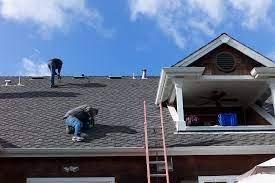Last Updated on July 19, 2024 by Asfa Rasheed
Investing in a new roof is an important decision that impacts your home’s aesthetics, durability, and energy efficiency. Skilled roofing experts use precise techniques to provide long-lasting and watertight protection.
Start with the basics: Install starter strips and shingles in an overlapping pattern and nail them to the roof deck. Next, waterproof the valleys and cap the ridge. Finish the job with flashing and sealing around chimneys, vents, and protrusions.
Table of Contents
Preparation and Planning
The first step of a successful roof installation involves adequate preparation. This stage is crucial for various reasons, including ensuring safety and addressing underlying issues.
This includes a thorough inspection to determine the scope of work. It also means clearing the attic or other storage areas of furniture, heirlooms, or valuables that might be exposed to dust and debris during the project. Covering or moving any outdoor yard decorations, potted plants, or other items the project might damage is also a good idea.
Once the inspection and prep have been completed, it’s time to start installing the new materials. Roofing experts carefully lay down the chosen roofing material, ensuring that it meets quality, aesthetic, and performance standards. Other steps in this phase include installing vents and ridge caps. Vents help regulate attic temperature and improve energy efficiency, while ridge caps provide a protective and aesthetically pleasing finish to the roof’s peak.
Materials
A roof is one of the most important elements in a home, protecting the structure and mechanical systems from weather damage. In addition, a quality roof can increase the resale value of a house.
There are many roofing materials available for homeowners to choose from, depending on their preferences and needs. Some of the most common are asphalt shingles and cedar shingles. Other options include metal sheets, terra cotta tiles, and concrete tiles. Each of these materials comes in various colors, textures, and designs.
In addition to laying the primary roofing material, the roofer will install flashing around chimneys, windows, and joints. They will also cover the roof sheathing with a waterproof layer of tar paper. In areas where ice dams are a problem, a membrane is added to the roof to prevent melting ice from backing up under the shingle and damaging the sheath underneath. These protective layers are then covered with shingles, which are fitted to overlap each other to create a watertight seal.
Installation
A professional roofer has the experience and expertise for roofing installation, protecting your home and adding value. They can choose the roofing material that best meets your budget, architectural style, and climatic conditions.
Before the roofing work begins, the contractor will inspect the existing roof structure to evaluate damage or rot and determine whether it is structurally sound. They will also assess the amount of materials required.
If constructing an asphalt roof, the contractors will remove the old shingles using a shingle fork. They will then lay a layer of underlayment to protect the roof deck from water leaks. The next step will depend on the type of roof you have:
For example, metal roofs are installed in large panels and may require additional elements like flashing or vents to allow for airflow. Other types of roofing may include ridge vents and specialized shingles that add protection and aesthetic appeal to your roof.
Quality Checks
Roofing professionals must perform a series of quality checks throughout the installation process. These checks ensure that all aspects of the project are up to standard and that the finished roof meets the homeowner’s expectations and specifications.
These inspections are performed with the help of standard roofing tools like shingles, hammers, nail guns, ladders, and shingle cutters, as well as construction equipment such as forklifts and tractors. In addition, workers wear protective gear such as hard hats and harnesses to avoid falls and other accidents on the job site.
All roofing materials must be installed properly and per the manufacturer’s instructions. Regularly performing quality inspections using digital forms ensures these checks become integral to each procedure rather than an additional task. For example, a roofing contractor should use the tool to check that a shingle is the right size and has the correct amount of adhesive on its back before installing it. The tool should also be used to verify that the proper number of shingles is used.
















